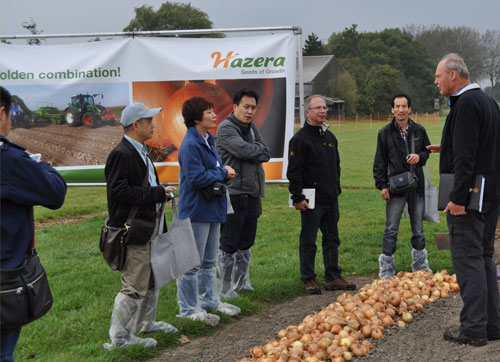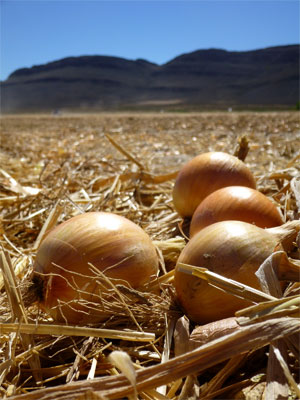Made, The Netherlands
June 26th 2015
Onion is one of the most grown vegetable crops in the world. It is a real tastemaker in all kinds of dishes and is consumed all over the world. Besides taste, onions offer many healthy ingredients that are much appreciated by modern consumers.
Many consumers might not be aware of it, but a lot of activities and expertise are required to create the onion varieties that fulfil the needs of farmers, processors, trade and consumers. One of the companies that are at the basis of high quality onions is Hazera, one of the leading vegetable seed companies worldwide. Within a period of ten years, the company’s market share has gone up to twelve percent of the world’s onion seed market. Who is this dynamic player on the market? We asked Wim van der Heijden, Hazera’s Global Product Manager for Root & Bulb crops.

“Hazera markets a whole range of vegetable crops, and onion is one of our largest and a strategic crop”, explains Wim. “Our star has risen quickly since 2008 when the forces of several companies specialized in onion breeding were combined into the new Hazera company of today. But our tradition in onion breeding is much longer. Since 1974 we’ve been investing in Research and Development of high performing hybrid onion varieties, especially in the Extra Long Day segment (for regions at latitude above 50°) and the Short Day segment (latitude up to 30°). With these hybrid varieties, we have achieved strong improvement of yields and quality. New traits and characteristics for the benefit of growers, industry and consumers could be introduced much faster, taking the crop quickly to higher levels.”
When we say “quality”, what are we talking about? Wim: “To cite some examples: uniformity of the seeds to enable precision sowing, increase of the so-called 1000-seeds-weight bringing more power in the seeds for more vigorous plants, several skin layers to protect the onion during processing and transport, high dormancy preventing regrowth of the bulbs. Also very important: a round uniform shape that goes along with improved yields, facilitates harvesting and processing and gives a more attractive product on the supermarket’s shelf. Another appreciated quality is flexibility: varieties that can be sown as well as transplanted and that can stand very different climatic conditions.

One of the most important improvements we have been working on since the beginning is a higher firmness of the onion, making it suitable for long storage. Such an improvement takes hard work and a long breeding process during which you have to make the right choices continuously. We succeeded, and now we offer the best storable onions in the world that also give high yields, like our breakthrough varieties Centro and Dormo (Extra Long Day) or Taresco (Long Day). A golden combination, that we offer not only in the Extra Long Day, but also in other types. We’re even
introducing it now in the Short Day type, for example in our red variety Neptune, and it’s quite promising.”
Very important point of attention is disease resistance. Wim: “We started to develop disease resistance back in 1986, and made considerable investments. A breakthrough was the introduction of High Resistance to Downy mildew, a devastating disease that can destroy complete harvests. Our variety Santero offering this resistance was very welcomed also by organic growers who suffered much from this disease. And now we are anticipating worldwide growing disease pressure from the soil by developing varieties featuring resistance to Pink root and Fusarium, such as Miss Scarlet that we recently introduced.
Another focus in breeding are colored varieties. “Next to the classic yellow onion, we’ve extended our range to red, pink and even white onions. Highlight in this segment is Sivan, with a nice pink color, high reliability and flexibility for the grower, and a delicious mild taste for the consumer.”
All this hard and systematic work over several decades, based on extensive investment In R&D (in total over 15% of the company’s turnover), had to lead to results. Wim: “In several segments and regions, we are now writing double digit growth figures, not only compared with 5 years ago, but even with last year’s results. We reached these results in for example Western Europe, Eastern Europe, the Middle East, Africa and Oceania. In Asian countries like the Philippines, India or Pakistan, and in other countries such as Morocco and Brazil, perspectives are very good for further growth.
Hazera currently holds the onion market leader position in a whole range of countries around the globe, like Germany, Israel, Belarus, the Middle East region including Saudi Arabia, the Dominican Republic or Greece. And it is the upcoming second party in Benelux, Scandinavia, France, UK, Poland and Peru. The company is also moving up in Australia and New Zealand, countries for which it has been breeding Intermediate type varieties with high yield and long storability for export.
What about the onion’s future? Wim: “an important part of it is in our hands indeed, and we’ll continue to invest extensively in research and in the development of innovations for markets worldwide. Yield and storability will further increase, and we’ll add improved earliness to the crop. We’ll bring new disease resistances for a healthier crop that can be grown with less chemicals. Very promising are our Set Onions. These are young prepared plants that are planted very early in the season for very early harvesting (already from June), enabling year round supply and extending the zones where onions can be grown. From the year 2011 we’ve achieved double digit growth also in set onions.”
So more developments will be coming up from Hazera. “One of the things that keeps us going is the appreciation we receive from the onion supply chain in all parts of the world. We are ready to further improve this healthy and tasty crop!”